
|
| Taken outside the butterfly farm. (Big image, small) |




We were down in the lobby and checked out well before 7:00 this morning, ready to be picked up by our guide Leonardo Chávez, and he showed up at seven precisely. Leo is a wiry guy with dark hair and a ready smile, about 5′ 8″ tall, full of energy and full of information. We were the only members of the group staying at the Grano de Oro, so we went on to the Cariari to pick up the others. First into the bus was Joan Berkowitz, then Sean Gaskie and Lin Max, then Judith LaBelle and Neal Brown. Our driver’s name was Sergio. He turned out to be a fabulous spotter of birds and other wildlife, so was an extra benefit to us beyond his skillful driving.

|
| (Big image, small) |
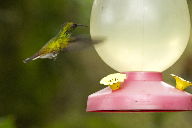
|
| (Big image, small) |
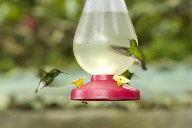
|
| (Big image, small) |
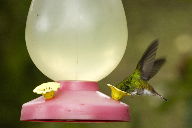
|
| (Big image, small) |
Our first stop of the day was to a butterfly farm, that is, an enclosure where chrysalises were brought, to be allowed to open and release their butterflies. But before that, we passed by a hummingbird feeding station consisting of three or four nectar feeders for the hummers. And the air was alive with them. The Costa Rican hummingbirds don’t seem to be territorial in the manner of our Eastern Ruby Throats, or the Anna’s that we have in Pasadena: they buzzed about in close proximity to each other apparently all unconcerned. Here the very nice macro lens that I had bought for my Canon camera came in very handy: it’s of rather long focal length, and as you see at the left, it made very satisfactory images of the birds, since they were only about ten feet from us. Leo told us that although Costa Ricans love birds and like to keep birds in cages, the practice of setting up feeders is not wide-spread.
| ||||||||||||||||
|
We went into the butterfly enclosure through a double door, designed to minimize the escape of the inhabitants. And there were plenty of these, including Blue Morpho, Morpho helena, but these are so erratic in flight, and look relatively so dull when resting with wings folded, that neither Mark nor I were able to get any kind of picture of them. But I did get a number of shots of the “Owl Eye” (Caligo sp.), sharing a piece of rotting fruit with a whole bunch of fruit flies. The very pretty brown and white one in the second row and the plainer tan one in the third at right I know nothing about. But they too were cooperative enough to hold still for the camera. The next three pictures at the right are not as clear as I would have liked, but I did want to show them anyway. Finally, the chrisalises hanging in the display case are usually kept in the dark; the label at the left may not be easy to read, but it says that the chrysalis it’s attached to is of a Blue Morpho.
From there we went off to an unpretentious Costa Rican home, where Rosa, the lady of the house, had prepared for us tortillas, potatoes, fried yuca (cassava), agua dulce (boiled sugar cane juice, not too sweet, which could be flavored with juice of tangerine lemon), and of course coffee. This was the first of several visits to people’s houses that Leo arranged, and I think it was one of the most attractive aspects of the tour.
Rosa’s son does very charming sculptures of toucans and parrots out of tires that he slits appropriately and paints. The bills and part of the heads are made of wood that he nails the rubber to, but the figures are almost all tire. They’re really clever.
Our next objective was the La Fortuna Falls, which we would get to in our first walk. On the way to the trail head, we stopped a couple of times to get views of Three-toed Sloths and Toucans. Very satisfying, but they weren’t well positioned for photographing.
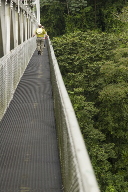
|
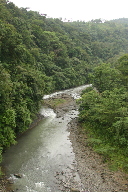
|
| (Big image, small) | (Big image, small) |
A bit after that, as we were driving across a bridge, Sergio spotted a sloth in a tree. So we parked on the far side of the gorge, and walked back across the bridge. The walkway had openwork flooring, so Mark had a little trouble keeping his vertigo in check. You can see him doing just that at the extreme left. But we did see the sloth, and I tried photographing it, but the results were most horrid (see below), because I had the short-focus lens on the camera, just not good enough. There was also an iguana in a tree, but for some reason I didn’t try to capture that. I did get some shots of the gorge and the river below, with the rain-forest to one side, and there’s one of them over to the left.
| ||||
|
The La Fortuna Falls are very fine, but I’m sorry to say that for most of this walk, it was out of the question to take the camera out, because of the heaviness of the rain. The way down was steep, but well furnished with steps, mostly constructed of cinder-block, so there was little chance of slipping. Of course it’s always tough on the knees to go down so steeply, even with the benefit of a walking stick. Anyway, at the right you see Mark walking the trail—ahead of me as always. And below him, two shots of the falls that I did pull when we got to the bottom.
For lunch, we walked to an open-air restaurant, very pleasant, especially with the rain coming down around us. For starters, there was a choice of ceviche or hearts-of-palm salad, and I chose the latter, thinking that the ceviche might be very filling. And indeed, one of the others in the group said that the ceviche could have been a meal in itself. One of the main dishes was sea-bass with garlic, and very garlically aromatic it was: I rather regretted not choosing it when I got a whiff of all that delicious garlic. But I chose sea-food with rice, though, thinking that this would maybe be lighter. Everybody did exclaim over the sea-bass: it’s a commonly-served fish here, and the Costa Ricans definitely know how to cook it.
At this restaurant, we saw, as a group, our first demonstration of Costa Rican filter-coffee preparation, with a long cloth filter that the hot water is carefully poured into, with stirring of the grounds. I had seen this many years ago in graduate school, when a fellow student from Costa Rica made coffee for me, so I knew what to expect. Paired with the fine coffee of Costa Rica, the method gives an excellent result.
|
|
After lunch, which was rather late, we did a timed walk of about thirty minutes, so that we could get to our hotel, the Arenal Observatory Lodge, before dark. The idea was that no matter where we were on our path at the end of half an hour, Sergio would drive the bus to meet us, and whisk us to our lodgings.
The rain had let up somewhat, so I felt that I could take some shots. But it was late in the day, 4:35 in fact, and the clouds made the surroundings even darker. But the lush green of the rain forest shows up well, and in the tall picture to the right you should notice the tree in the distance, thoroughly covered with epiphytes: as I’ve noticed before, it’s just things growing on things growing on things. There’ll be many more pictures showing this later on.
We got to the Lodge as dark was closing in. The place is broad in extent, with nice gardens, and from the rooms, given a clear atmosphere, there would be a clear view of Arenal, the volcano that erupted unexpectedly in 1968 and has been active ever since. It’s considered Cost Rica’s most active. Our room was a five-minute walk from the restaurant, and this night, there was enough rain to make protection necessary. Our room itself is big, with a nice bathroom in European style: fully tiled floor, with the shower set off by nothing but a curtain, and with a drain right in the floor nearby.
Dinner would be at eight, but Mark and I wanted to get to working on our journals as soon as possible, so we went to the bar not long after six, and ordered a glass of red each. I worked up several pages, and then the exhaustion hit. I retired to a soft easy-chair nearby in hopes of grabbing a little nap—I’m not sure that I actually slept, but the respite was plenty worth while.
Towards eight, the group congealed at our table, and we sat down to a nice meal. I had a rather rich cream of asparagus soup, and a pleasant-enough tilapia dish. We all were so eager to get to bed that nobody had coffee or dessert.
A pyroclastic flow is a fast-moving current of superheated gas that also carries rock in it. It was such a flow from the Montagne Pelée that destroyed the city of Saint-Pierre on Martinique in 1902. And a pyroclastic flow was one aspect of the eruption of Mount St. Helens in 1980.
The Lodge was established as a place for geologists to stay when they were observing and keeping tabs on Arenal, which is still quite dangerous. It still is capable of producing pyroclastic flows, and a number of the trails in the area have been closed, due to danger from the volcano. I slept completely soundly this first night in the lodge, but some of the others heard the thump of ejected boulders hitting the side of the mountain, and saw the glowing rocks as they fell. But see our reports for the next night: MTK, JDL.

|
| Can you see the sloth? |
Next day’s pictures, previous day’s pictures. Return to the central Costa Rica page; to the central travel page; to my home page.